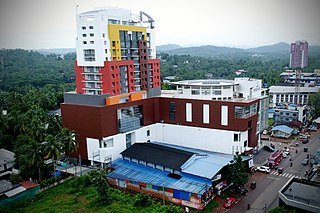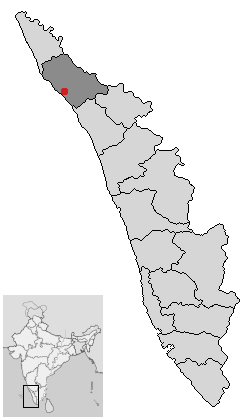Related Research Articles

Kozhikode, official name until 1990 was Calicut, is a city along the Malabar Coast in the state of Kerala in India. Known as the City of Spices, Kozhikode is listed among the UNESCO's Cities of Literature.

Malappuram, is one of the 14 districts in the Indian state of Kerala, with a coastline of 70 km (43 mi). The most populous district of Kerala, Malappuram is home to around 13% of the total population of the state. The district was formed on 16 June 1969, spanning an area of about 3,554 km2 (1,372 sq mi). It is the third-largest district of Kerala by area. It is bounded by Western Ghats and the Arabian Sea on either side. The district is divided into seven Taluks: Eranad, Kondotty, Nilambur, Perinthalmanna, Ponnani, Tirur, and Tirurangadi.
The folklore of India encompasses the folklore of the nation of India and the Indian subcontinent. India is an ethnically and religiously diverse country. Given this diversity, it is difficult to generalize the vast folklore of India as a unit.

The Malayali people are a Dravidian ethnolinguistic group originating from the present-day state of Kerala & Union Territory of Lakshadweep in India, occupying its southwestern Malabar coast. They form the majority of the population in Kerala and Lakshadweep. They are predominantly native speakers of the Malayalam language, one of the six classical languages of India. The state of Kerala was created in 1956 through the States Reorganisation Act. Prior to that, since the 1800s existed the Kingdom of Travancore, the Kingdom of Cochin, Malabar District, and South Canara of the British India. The Malabar District was annexed by the British through the Third Mysore War (1790–92) from Tipu Sultan. Before that, the Malabar District was under various kingdoms including the Zamorins of Calicut, Kingdom of Tanur, Arakkal kingdom, Kolathunadu, Valluvanad, and Palakkad Rajas.

Manjeri is a major town and municipality in Malappuram district, Kerala, India. It is the fourth-most populous municipality in state. It is situated 23 kilometres (14 mi) southeast to Karipur International Airport and 13 kilometres (8.1 mi) northeast to Malappuram, the district headquarters, and forms a part of Malappuram metropolitan area. It is one of the major commercial towns under the Malappuram urban agglomeration and serves as the headquarters of Eranad Taluk. Manjeri Municipality is a Local Self Government Institution with a jurisdiction of three villages namely Manjeri, Payyanad, and Narukara.

Malabar District, also known as Malayalam District, was an administrative district on the southwestern Malabar Coast of Bombay Presidency (1792–1800), Madras Presidency (1800–1937), Madras Province (1937–1950) and finally, Madras State (1950–1956) in India. It was the most populous and the third-largest district in the erstwhile Madras State. The historic town of Calicut was the admisnitrative headquarters of this district.

Malappuram is a city and the headquarters of the Malappuram district in Kerala, India. It is the 4th largest urban agglomeration in Kerala and the 20th largest in India, spread over an area of 158.20 km2 (61.08 sq mi) including the surrounding suburban areas. The first municipality in the district formed in 1970, Malappuram serves as the administrative headquarters of Malappuram district. Divided into 40 electoral wards, the city has a population density of 4,800 per square kilometre. According to the 2011 census, the Malappuram metropolitan area is the fourth largest urban agglomeration in Kerala after Kochi, Calicut, and Thrissur urban areas and the 20th largest in India with a total population of 3 million. It is the fastest growing city in the world with a 44.1% urban growth between 2015 and 2020 as per the survey conducted by Economist Intelligence Unit (EIU) based on the urban area growth during January 2020. Malappuram is situated 54 km southeast of Calicut and 90 km northwest of Palakkad. It is the first Indian municipal body to provide free Wi-Fi connectivity to its entire residents. Malappuram is also the first Indian municipal body to achieve the International Organization for Standardization certificate. It is also the first complaint-free municipality in the state.
Mappila songs are a folklore Muslim song genre rendered to lyrics, within a melodic framework (Ishal), in Arabi Malayalam by the Mappilas of the Malabar region in Kerala, India. Mappila songs have a distinct cultural identity, while at the same time remain closely linked to the cultural practices of Kerala.
Jenmi or Janmi, plural Jenmimar, is the Malayalam term used to refer to the landed aristocracy of Kerala who traditionally held their lands as absolute and allodial owners, with such lands known as Jenmom or Janmam. They formed the landowning nobility as well as the landed gentry of the region in colonial times, and the majority of the estates and feudal properties were owned by this community. They predominantly belonged to the Nambudiri and Nair castes.

Edathanattukara or Kottappalla is a town in Palakkad District, Kerala, India.

The Mannanar dynasty was a Thiyya dynasty in Malabar, near present-day Kannur and Kasaragod districts of Kerala. The ruins of Mannanar palace can still be seen at the foothills of the Ghats borders of Coorg. The ancient palace in Eruvesi to the northwest of Taliparamba was called as Anju Aramana. Kunnathoor Padi, Muthappan Madapura and Padikutti were their royal family temples.
The total population of the Nair community is disputed, since there has been no caste-based census since 1931. However, various sources cite figures ranging from 12% to 15%. There is also the practical difficulty of certain Nair subcastes considered as independent castes. Out of the citizens eligible to vote in Kerala, around 12% or 15% belong to the Nair community. The most reliable population figures comes from two sources. The BCRC estimated Nair population at 14.47% of the total population of Kerala based on a statewide sample survey conducted for the reservation of seats in educational institutions.

The Malabar rebellion of 1921 started as a resistance against the British colonial rule in certain places in the southern part of old Malabar district of present-day Kerala. The popular uprising was also against the prevailing feudal system controlled by elite Hindus.
The Panar are a community found mainly in various districts of Karnataka including Kundapura Taluk and Udupi District, India.
Malappuram is one of the 14 districts in the South Indian state of Kerala. The district has a unique and eventful history starting from pre-historic times. During the early medieval period, the district was the home to two of the four major kingdoms that ruled Kerala. Perumpadappu was the original hometown of the Kingdom of Cochin, which is also known as Perumbadappu Swaroopam, and Nediyiruppu was the original hometown of the Zamorin of Calicut, which is also known as Nediyiruppu Swaroopam. Besides, the original headquarters of the Palakkad Rajas were also at Athavanad in the district.

Odiyan (transl. Shapeshifter) is a 2018 Indian Malayalam-language fantasy drama film directed by V. A. Shrikumar Menon in his feature film debut. The film was written by Harikrishnan; it is based on the legend of the Odiyan clan, who in Kerala folklore are men believed to possess shapeshifting abilities and can assume animal forms. Odiyans are said to have inhabited the Malabar region of Kerala before the widespread use of electricity. The film stars Mohanlal in the title role, alongside an ensemble cast of Prakash Raj, Manju Warrier, Siddique, Innocent, Manoj Joshi, Sana Althaf, Kailesh, Narain, Sreejaya Nair and Nandhu Krishnamoorthy; it was produced by Antony Perumbavoor through Aashirvad Cinemas.
Dr. Shimna Azeez is a medical doctor and public health worker. She is a published writer who has two popular books to her credit, and a social media influencer who is widely read online, and in print media. Dr. Shimna is also an accomplished public speaker, and has presented on various health related topics on national and international platforms including Misinformation in Medicine Forum, Singapore; a ‘Google News Initiative’ to build collaboration between doctors, technologists and media professionals to combat the misinformation epidemic in health in Asia; at Google HQ, Singapore in December 2019.

Malaysian Malayalees, also known as Malayalee Malaysians, are people of Malayali descent who were born in or immigrated to Malaysia from the Malayalam speaking regions of Kerala. They are the second largest Indian ethnic group, making up approximately 15% of the Malaysian Indian population. The bulk of Malaysian Malayali migration began during the British Raj, when the British facilitated the migration of Indian workers to work in plantations, but unlike the majority Tamils, the a large number of the Malayalis were recruited as supervisors in the oil palm estates that followed the kangani system, and some were into trading and small businesses with a significant proportion of them running groceries or restaurants. Over 90% of the Malayalee population in Malaysia are Malaysian citizens.

South Malabar refers to a geographical area of the southwestern coast of India covering some parts of the present-day Kerala state. South Malabar covers the regions included in present-day Kozhikode taluk of Kozhikode district, the whole area of Malappuram district, Chavakkad taluk of Thrissur district, and Palakkad district, excluding parts of Chittur taluk. The Fort Kochi region of Kochi city also historically belongs to South Malabar. The term South Malabar refers to the region of the erstwhile Malabar District south to the river Korapuzha, and bears a high cultural similarity to both the Cochin and the North Malabar regions.
References
- ↑ Bresnan, Patrick S. (December 27, 2021). "Awakening: An Introduction to the History of Eastern Thought". Routledge – via Google Books.
- ↑ Rao, M. S. A. (September 5, 1957). "Social Change in Malabar". Popular Book Depot – via Google Books.
- ↑ Dare, Marcus Paul (September 5, 1940). "Indian Underworld: A First-hand Account of Hindu Saints, Sorcerers, and Superstitions". E.P. Dutton & Company, Incorporated – via Google Books.
- ↑ Keezhayi, UK Kumaran Translated by: Jayasankar (August 19, 2023). "Thakshankunnu Swaroopam: Translation of an Epic level Malayalam Historical Novel, panning 100 Years of a Region's Struggles for Political Independence and Social Justice, Captured Through the Lives of Over 100 Real and Imagined Characters". Notion Press – via Google Books.
- ↑ Innes, Charles Alexander (September 5, 1915). "Malabar and Anjengo". Superintendent, Government Press – via Google Books.
- ↑ Thurston, Edgar (2021-01-01). Omens and Superstitions of Southern India: Popular Books by Edgar Thurston : All times Bestseller Demanding Books. Beyond Books Hub.
- ↑ Woodburne, Angus Stewart (September 5, 1927). "The Religious Attitude: A Psychological Study of Its Differentiation". Macmillan – via Google Books.
- ↑ Fawcett, F. (February 1, 2004). "Nâyars of Malabar". Asian Educational Services – via Google Books.
- 1 2 3 4 5 6 7 Government Museum (Chennai) (September 5, 1900). "Bulletin". Superintendent, Government Press – via Google Books.